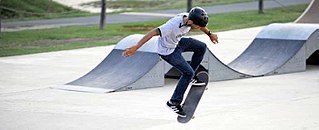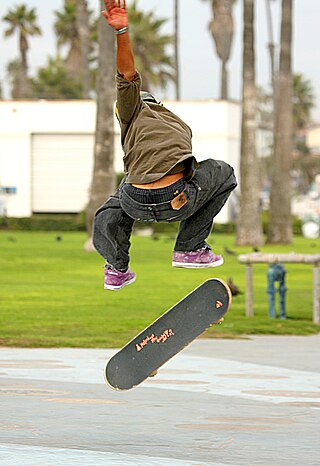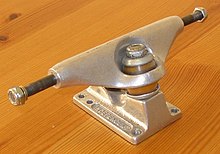
A skateboarding trick, or simply a trick, is a maneuver performed by manipulating a skateboard, usually with one's feet, in a specific way to achieve the desired outcome – the trick.

The kickflip is a skateboarding trick, in which the rider flips their skateboard 360° along the axis that extends from the nose to the tail of the deck. When the rider is regular footed the board spins clockwise if viewed from the front.

An Indy grab, also known as an Indy air, is an aerial skateboarding, snowboarding and kitesurfing trick during which the rider grabs their back hand on the middle of their board, between their feet, on the side of the board where their toes are pointing, while turning backside. This trick is done only backside; the same maneuver done while turning front side, is called a front side air. The Indy grab is a generic skateboarding trick that has been performed since the late 1970s. This trick is performed mainly while vert skating, e.g. on halfpipes. Although this move can be done on flat land, it is much easier on a ramp. The Indy grab is one of the basic tricks in vert skating and is usually combined with spins, kickflips and heelflips.

John Rodney Mullen is an American professional skateboarder who practices freestyle skateboarding and street skateboarding. He is considered one of the most influential skateboarders of all time. Mullen is credited for inventing numerous tricks, including the flatground ollie, kickflip, heelflip, impossible, and 360-kickflip. As a result, he has been called the "Godfather of freestyle skating."

A longboard is a type of skateboard typified by longer decks and wheelbases, larger-diameter and softer (lower-durometer) wheels, and often lower riding height compared to street skateboards, though there is wide variation in the geometry and construction of longboards. Among the earliest types of skateboards, longboards were inspired by surfing, with early longboards drawing from the design of surfboards, resembling and mimicking the motion of riding a surfboard, but adapted to riding on streets in a practice known as sidewalk surfing.

Longboarding is a variation of skateboarding typified by the use of longer boards ("decks") with longer wheelbases and softer wheels. While longboards vary widely in shape and size, compared to street skateboards longboards are designed to be more stable at speed and to have more traction due to larger wheel sizes and softer wheel durometers. While standard street skateboards may typically be between 28 and 34 inches long, longboards can range anywhere from 32 to 50 inches in length. Ride characteristics of longboards generally differ from that of street skateboards due to the use of specialized longboard trucks that have different properties than those typically used with skateboards; while street skateboards use "traditional kingpin" (TKP) trucks that are optimized for tight turning radii, ollie and flip tricks, slides, grinds, and transition skating, longboards are typically paired with "reverse kingpin" (RKP) trucks that are designed for increased stability at higher speeds, more "surfy" carving characteristics, and/or greater ride comfort for commuting over longer distances.

The ollie is a skateboarding trick where the rider and board leap into the air without the use of the rider's hands. It is the combination of stomping the tail of the skateboard off the ground to get the board mostly vertical, jumping, and sliding the front foot forward to level out the skateboard at the peak of the jump.
In surfing, skateboarding, snowboarding and aggressive inline skating, frontside and backside are terms that are used to describe how a person approaches an obstacle or performs a certain trick. In aggressive inline skating, frontside and backside are types of grinds.
A freestyle skateboarding trick is a trick performed with a skateboard while freestyle skateboarding. Some of these tricks are done in a stationary position, unlike many other skateboarding tricks. The keys to a good freestyle contest run are variety, difficulty, fluidity, and creativity. This is an incomplete list, which includes most notable tricks.
A varial flip is a type of skateboarding trick in which the skateboard rotates around its vertical axis, or its vertical axis and its horizontal axis simultaneously. The first flip trick, called a kickflip but originally known as a "magic flip", was invented by professional skateboarder Rodney Mullen.

A slide is a skateboarding trick where the skateboarder slides sideways either on the deck or the trucks.
The no comply is a skateboarding trick that was invented by John Lucero and then named and popularized by the skater Neil Blender in the 1980s.

In skateboarding, a nollie, short for "nose ollie", is an ollie executed at the front of the board while the rider is positioned in their natural stance. Professional skateboarders Karl Watson, Shuriken Shannon, Tuukka Korhonen, and Sean Malto have been recognized for their ability to perform the nollie trick. A nollie can be easily confused with a fakie ollie, whereby the rider uses their original foot position but is instead riding backwards.

Tensor Trucks is an American skateboarding truck company founded and designed by professional skateboarder, Rodney Mullen, in 2000. Tensor's parent company is Dwindle Distribution. The brand offers trucks in three different heights that are tailored for different wheel diameters—the hi is designed for 58mm wheels and smaller; the mid for 54mm or smaller; and the lo for 52mm and smaller. Mullen holds US patent no. 6,443,471B1 for design features implemented in Tensors. Tensor's trucks are manufactured in China.

The Wallenberg Set, also known as the Wallenberg Four or simply Wallenberg, is a popular location in the skateboarding community. Located at the Raoul Wallenberg Traditional High School in San Francisco, California, it consists of four tiers of pavement and curbing, adjacent to a stairway and next to a parking area. The section notable for skateboarding measures 4 feet 4.8 inches (1.341 m) in height and 16 feet 6 inches (5.03 m) in length.

A caster board, vigorboard or waveboard is a two-wheeled, human-powered land vehicle. Other names are J-board and RipStik, both of which are derived from commercial brands.

A skateboard is a type of sports equipment used for skateboarding. It is usually made of a specially designed 7–8-ply maple plywood deck and has polyurethane wheels attached to the underside by a pair of skateboarding trucks.
A fingerboard is a scaled-down replica of a skateboard that a person "rides" with their fingers, rather than their feet. A fingerboard is typically 100 millimeters (3.9 in) long with width ranging from 26 to 55 mm, with graphics, trucks and plastic or ball-bearing wheels, like a skateboard. A fingerboard can be used to do traditional skateboarding tricks, such as an ollie and kickflip.

A shove-it is a skateboarding trick where the skateboarder makes the board spin 180 degrees without the tail of the board hitting the ground under their feet. There are many variations of the shove-it but they all follow the same principle: The skateboarder's lead foot remains in one spot, while the back foot performs the "shove". The pop shove-it was originally called a "Ty hop", named after Ty Page.

Street skateboarding is a skateboarding discipline which focuses on flat-ground tricks, grinds, slides and aerials within urban environments, and public spaces. Street skateboarders meet, skate, and hang out in and around urban areas referred to as "spots," which are commonly streets, plazas or industrial areas. To add variety and complexity to street skateboarding, obstacles such as handrails, stairs, walls, flower beds, bins, park benches, picnic tables, and other street furniture may be traversed as single tricks or as part of a series of consecutive tricks called a "line."



















